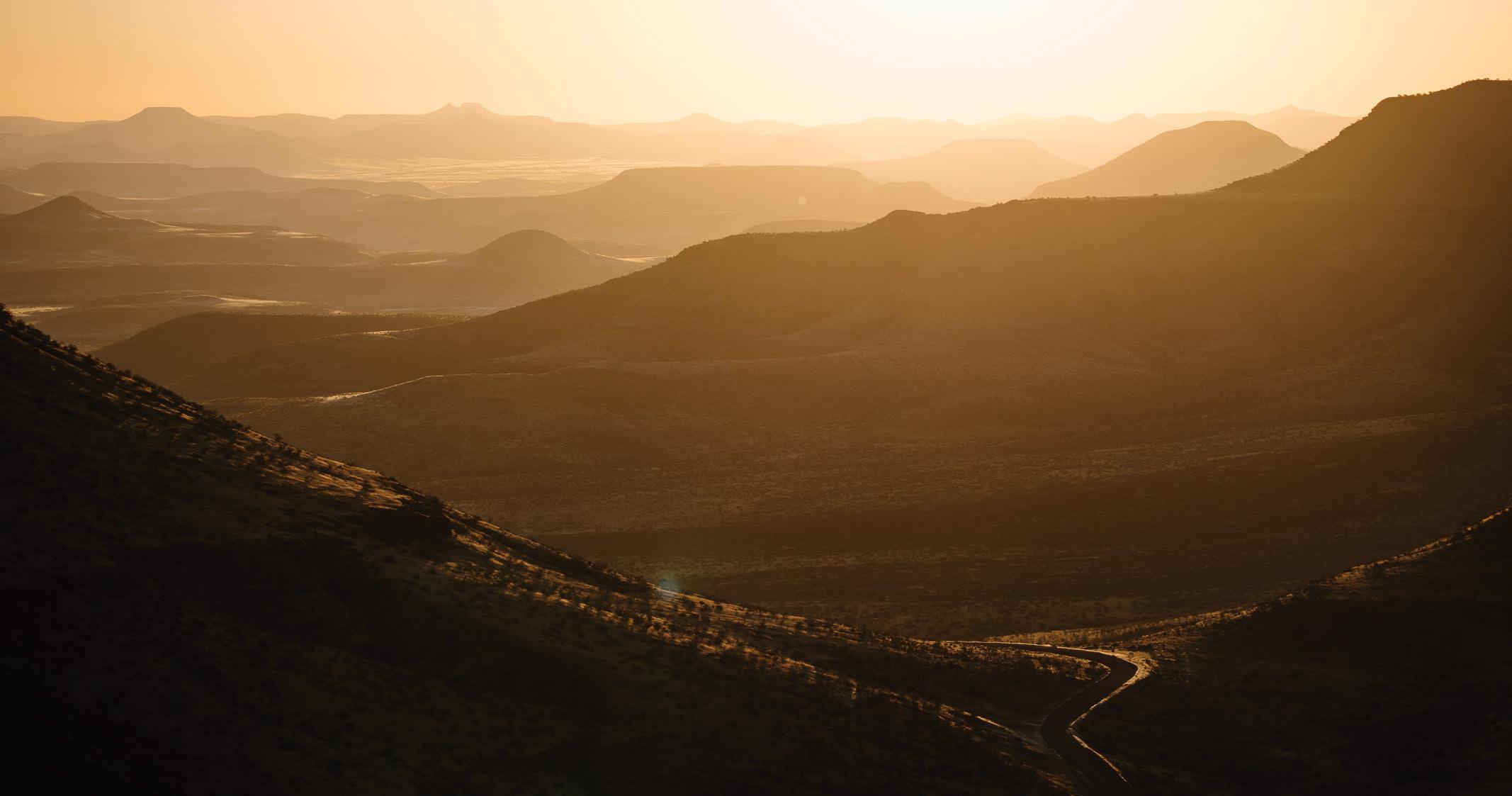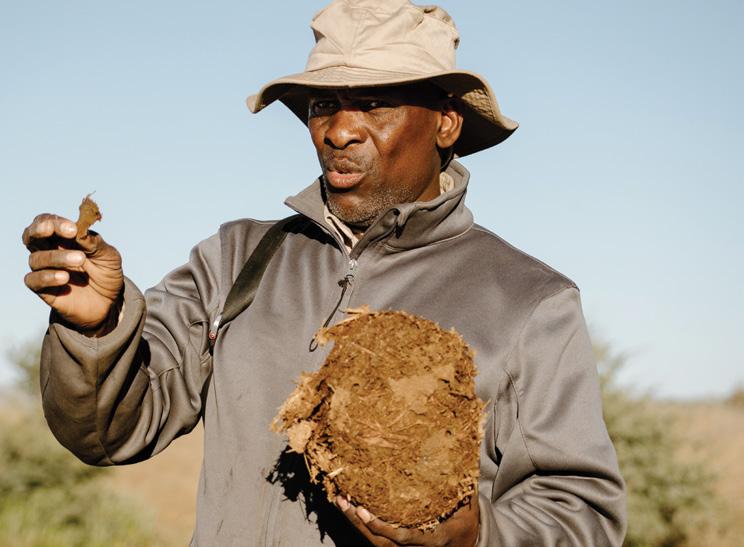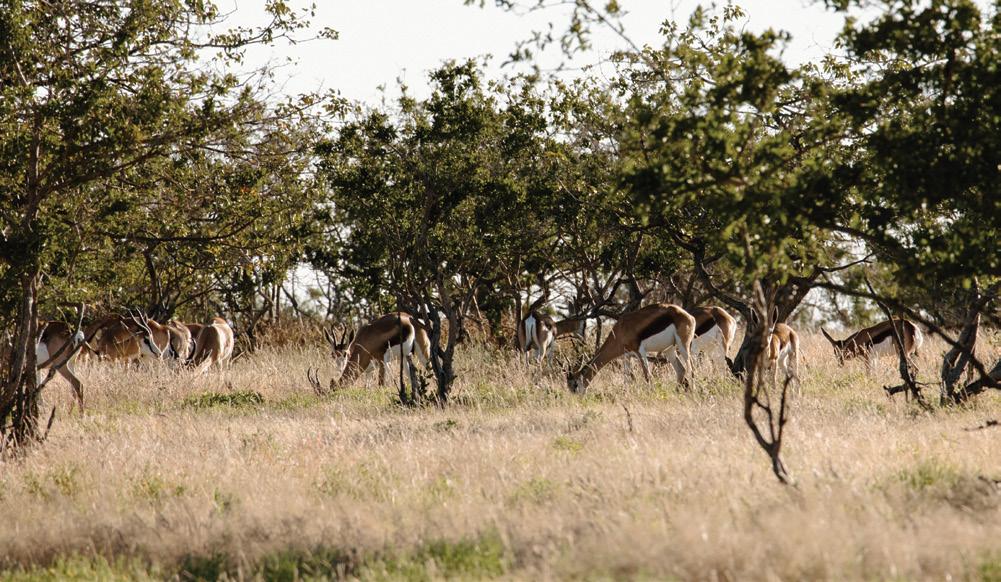
8 minute read
Grootberg Lodge
Mountains beyond mountains
Having explored much of Namibia, from the south to the central regions and even the far north, the remote Kunene Region has always held a special fascination for me. I have travelled to the dusty and bustling capital of Opuwo and visited the iconic Epupa Falls, but it is the areas in between –the long, quiet stretches of road scattered with rock and desert – that have always remained a mystery. Until recently.
Situated in the Kunene Region on the western edge of the Etendeka Plateau, Grootberg Lodge is perched at the very edge of the plateau, its valleys and layered escarpments extending across the surrounding, semi-arid landscape.
Departing from the small town of Kamanjab, the journey follows the C40 gravel road towards Palmwag. After 97 kilometres, the road suddenly signals a dramatic ascent, winding sharply up the escarpment to reach Grootberg Lodge. Due to the steep gradient, narrow bends and sheer drop-offs, the final stretch is reserved for skilled 4x4 drivers only. If you do not feel confident tackling the ride yourself, rest assured! Guests are met at the base of the mountain by a lodge guide or staff member, who handles the drive to the top. Vehicles remain safely parked under 24-hour security at the foot of the pass.
The climb is an experience in itself. Gravel and loose stone crush beneath our tyres as the 4x4 powers upward, revealing ever-expanding views of a Namibia I have never seen before. Upon arrival, we are welcomed with open arms, home-made iced tea and an opportunity to enjoy panoramic vistas from the lodge’s spacious dining room and deck.
Still weary from our travels, we are taken to the lodge’s accommodation. Nearly blending into the environment, snug stone-built, thatched-roof chalets are tucked along the edge of the mountain, offering scenic views of the expansive mountain range. Each chalet includes a private deck, perfect for soaking in the off-the-grid wilderness. As a trailblazer in sustainable eco-tourism, Grootberg Lodge operates entirely on solar energy. After a couple of lazy hours spent enjoying our private view and even indulging in the lodge’s daily tradition of coffee and cake, we are finally tempted to leave the cosy comforts of the lodge for a sundowner.
Skies dipped in gold
The Grootberg Plateau lies at an elevation of 1,551 metres and overlooks the Klip River Valley, on the eastern edge of the Etendeka Plateau. Yet some parts hardly resemble a mountain peak – we drive by broad swatches of flat carpeted plains, and no wonder, because Etendeka means “hill with flat top” in the Himba language.
Yellow and purple wildflowers bloom amid tall bushman grass, the landscape lush following Namibia’s abundant rainfall. Rosy-faced Lovebirds and Pale-winged Starlings gather in a verdant mopane tree (one of many native to this region), settling on its distinctively butterfly-shaped leaves. Apart from a herd of springbok spotted on the way, we note the visible absence of other wildlife, particularly antelopes such as gemsbok, kudu and klipspringers. But this is not bad news. In fact, we are told it is a result of the high rainfall this season. The animals have simply moved from the highlands down into the lowveld, where grazing is more plentiful.
Approaching the viewpoint, I am taken aback by the sky’s glimmering gold, with mountains and valleys stretching as far as the eye can see. We happen to all be locals on the sundowner trip. Wonderstruck, we exchange looks of disbelief, as if to say, “Is this really our Namibia?” For a moment, we simply stare, taking in the beauty.
Gradually, the horizon fills with soft hues of pale blue blending into fading, cool light. As the sun slips over the mountain, the temperature immediately drops. We snap a few last photos and take a final swig of gin and tonic served from a table generously laid out with snacks and refreshments, before clambering back onto our safari truck.
Back at the lodge, tender gemsbok steak is served, the dining room aglow with heaters and guests’ animated chatter. Later, we fall asleep to the sound of wind rustling through shepherd’s trees.
Elephant’s Corner
Part of the ≠Khoadi-//Hôas Conservancy (also known as “Elephant’s Corner”), Grootberg is the first lodge to be entirely owned by a communal conservancy – a legally registered area with clearly defined borders, managed by the local community for the development of residents and the sustainable use of natural resources and wildlife. Since its registration in 1998, the conservancy has been dedicated to protecting the area’s singular ecology and cultural identity. It was also the first conservancy in the region to reintroduce black rhinos and black-faced impalas. To help mitigate the impact of human-wildlife conflict, the Predator’s Fund was created to compensate farmers for livestock lost to predation. The lodge contributes to this fund by donating a fee for every predator sighting reported by guests.
Thanks to the conservancy’s collective efforts, the population of rare desert-adapted animals continue to roam freely, offering visitors a remarkable opportunity to observe these endangered mammals in their natural habitat. Desert elephant and rhino tracking is one of the signature excursions offered by the lodge. It is worth mentioning that sightings are never guaranteed, but that is all part of the adventure!
Keeping that little disclaimer in mind, we headed out early the next morning to track elephants. After a hearty breakfast buffet, we bundled up in oversized ponchos to shield ourselves from the blustery mountaintop wind. Specific to this area, the elephants are leaner and taller compared to their pachyderm counterparts in regions with more bountiful vegetation. They also possess wider feet for navigating the sandier terrain more easily. These elephants are known for their impressive memory and intelligence, enabling them to remember the locations of water sources and food supplies over vast distances. This knowledge is crucial for their survival in an environment like northwestern Namibia, where resources are scarce.
“Can you hear that?” Our guide, Ernst, slowly trails behind our tracker in the truck, scanning the road for fresh tracks and listening carefully. Naturally, we hear nothing, our ears untrained and unfamiliar, except for the sound of the howling wind. The tracker, though, deftly discerns subtle signs: the rough bark of a tree stripped clean by a dexterous tug of an elephant’s trunk, with branches snapped and strewn along the road like breadcrumbs. We stop at our first waterhole, where Ernst points to a fresh pile of elephant dung. Fibres from mopane leaves are clearly identifiable, meshed into the remnants of a magnanimous meal (the tree’s protein-rich leaves provide a steady staple for these gargantuan guardians).
At this point, we might have been close to finding them, but I was beginning to doubt that we would catch sight of anything at all. After hours of what felt like circling around quiet waterholes and combing tracks nearly swept away by the wind, my husband suddenly lets out a whistle and the truck screeches to a halt. At last, we get a glimpse of them – a family of twenty, all females, nearly hidden by the mopane woodlands.
Desert-adapted elephants are highly social animals that live in matriarchal herds, usually made up of related females and their offspring. These groups are led by a matriarch – the oldest and most experienced female – who plays a crucial role in navigating the herd to essential resources such as food and water. As males mature, they typically leave the herd and lead solitary lives or join small groups of other males, known as bachelor herds.
We waste no time. Ernst reverses, makes a sharp turn and follows the herd as they start to trudge towards the waterhole. We wait, cameras cradled in our hands, eyes peeled. Our anticipation builds as hazy brown figures in the distance emerge, transforming into majestic creatures. Trunks lift up in unison to lap up water, and younger ones are nudged closer. “Look, the matriarch is protecting her herd,” Ernst whispers in a low voice. She flaps her ears and stomps her feet, asserting her dominance. We keep our distance, admiring from afar. Fiercely protective, yet seemingly particular about their private space, the whole herd huddles behind a grove of trees to bathe, slinging mud over their backs. “They are shy, just like us!” We respectfully, albeit reluctantly, retreat to give them privacy. The wait has been well worth it. A front-row seat to nature’s own nobility.
To mark the moment, we linger for a final treat: a celebratory picnic lunch enjoyed beneath the shade of a shepherd’s tree. Talk amongst us drifts to grey, drizzly European skies and looming to-do lists awaiting everyone’s return. But for now, nestled into camp chairs, we embrace the stillness far from city life.
The steady rise back to Grootberg Lodge begins. I close my eyes and picture it clearly: the sweeping views of the valleys, waiting to welcome us back, stretching far into what feels like eternity.
Madeleen Duvenhage
To book your stay at Grootberg Lodge, visit: www.journeysnamibia.com















